Art-loving Physicist
It is costly to attend conferences in other continents. In addition to presenting papers and meeting old and new colleagues in my field. I would like to redeem the investment money by educating myslef. One way to do this is to visit museums and concert halls. I was fortunate enough to visit many (not all) of the museums listed on he this Wikipedia page. I also visited some museums not listed on this page.You are now invited to my collection of the photos from those museums.
- Orsay Museum in Paris (2000).
- Angelus by Jean-Francois Millet in the Orsay Museum. This image is from the public domain. The Museum does not allow photos in the gallery. This museum contains many paintings by Millet, who was quite fond of farmland landscapes. This painting has a great apeal to Koreans with farmland roots and Christian background. Here are more paintings Millet's Wikipedia page.
- Tahitan Women on the Beach by Paul Gauguin. Photos are not allowed in galleries, but this painting was a on a wall outiste the banquet room. In either case, this famous picture is in the public domain.
- This is the banquet room. When I was attending a conference in 2000, the banquet was held here.
- A Lonely Lady at the rooftop of the Museum (winter, Januaray of 2012), but I was with her in July of 2000.
- Entrance to the Gallery.
- View of the Gallery. a photo taken at a designated area. It is easy to see that museum building used to be a railway station.
- This Wikipedia
page contains more art items displayed this museum.
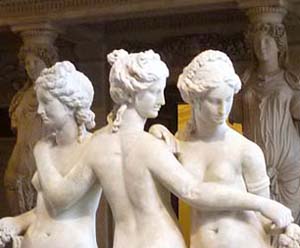
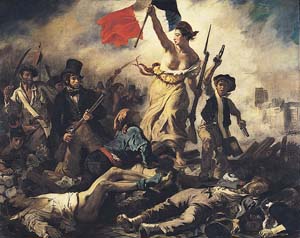
- Louvre Museum. I have been to
this museum several times. This museum allows photographing without flash,
and thus I have many photos. I would like to post some of them here.
- Glass Pyramid enhanced by two Parisians.
- Arc de Triomphe du Carrousel on the Museum ground called Carrousel. At the top of this arch.
- Three Greek Women, and woman pillars.
- Another Greek Woman.
- Mona Lisa. This is the most famous art item in this museum, and I took may photos of this lady, but I could not take better photo than this in the public domain.
- Egyptian and Colombian Ladies. God-created artworks are infinitely more valuable than Egyptian antiques.
- French Revolution by Eugene Delacroix. This painting is in the public domain.
- with Russian Students at the Persian Section.
- with Emperor Hadrian at the Roman section.
- Ultimate Lady: the statue
of Venus (Louvre Museum in Paris, 1998).
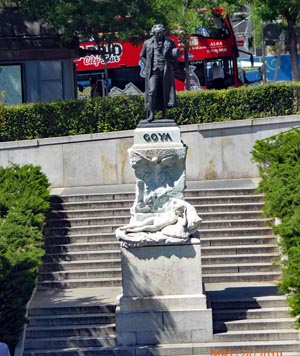
- Prado Museum in Madrid is one of the major art museums in
the world. I was there in 1992, 2001, and in 2019. The museum
became 200 years old in 20019.
We are not allowed to take photos inside the exhibition halls,
but you can see most of the important items from the
museum's Wikipedia page.
However, this restriction did not seem to apply in the entrance lobby.
- Here is a photo of myself in the main lobby in 1992.
- Another photo. These photos
prove that I was there.
- In 2001, I was there again and took photos of the museum building and its environment. Unfortunately, my camera was stolen in Madrid.
In 2019, I took a number of photos of the museum environment.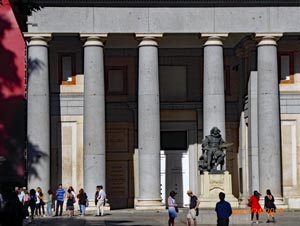
- Francesco Goya's statue is facing the northern entrance of the Museum building. Who is Goya?
- At the western entrance is a statue of
Diego Velázquez. However, this entrance is not open to the visitors.
The museum visitors enter the building through the northern door. The
ticket office is there, and the ticket line is very long as you can
see from this photo.
- Near the Prado Museum is the Neptune Fountain of Madrid. I was there in 1992.
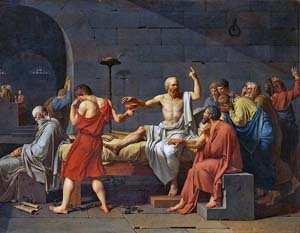
- Metropolitan Museum of Art
(2001).
- Greek warrior. (2001) and (2014).
- The Death of Socrates (2007). After seeing this painting, I went to the Agora Park of Athens where Socrates died. Click here for what Socrates means to me.
- with an art student from Japan. There are thousands of portrait of photos of important people in this museum, but there are not as important as one living student.
- Two Brazilian Ladies at the entrance of the Museum.
-
Click here for the Wikipedia page for this museum.
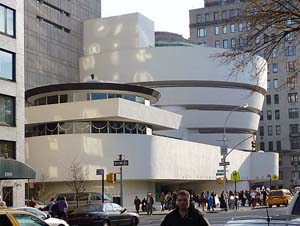
- Solomon Guggenheim Museum.
This landmark structure was designed by Frank Lloyd Wright and built in
1959, while I was a student at Princeton. I used to go there
often then, but not now. I still go there when they have important
events.
- Full Exterior View.
- Spiral Exhibition Floors. There are five floors.
- El Greco to Picasso Exhibition was held in 2006-7, and I was there.
- Artist from Croatia. It is always a pleasure to meet real people, instead portraits, at museums. I met this graphic artist from Dvornik and talked about her place. She invited me to visit her house when I come to that area. She was with her daughter.
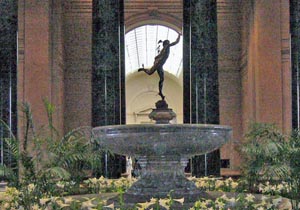
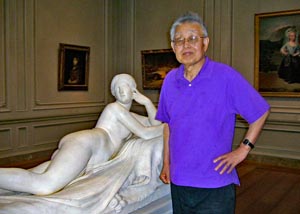
- National Gallery of Art
in Washington.
- Mercury Statue in the lobby of the Gallery.
- One of the exhibition rooms (2006).
- Paul Cezanne Exhibition (2006).
- The main entrance to the Gallery
is bout 300 meters from the Capitol building in Washington.
- This Gallery was constructed by
Andrew Mellon who donated it to his country called the United States
of America.
Andrew Mellon had a son named Paul. Undoubtedly he inherited some fortune from his father, but he multiplied his fortune to add a new building to the Gallery his father built.- Paul Mellon's East Wing seen from the ground of the Capitol building.
- This Wikipedia page shows the geography of the National Mall, and where the Gallery is located.
- Here is the NGA website.
From these buildings and their vicinity to the Capitol of the United States,
you can see how important the National Gallery is to Americans.
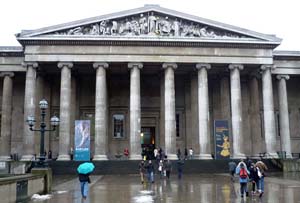
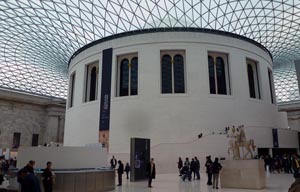
- The British Museum
is north of the Covent Garden. I was there for the first time in 1982. I was
interested in whether the statue of Buddha was a product of Greek art. When
the Greek troops of Alexander the Great went to the Punjab area
(now Pakistan and Afghanistan), they had to face Indian troops mounted on
elephants. They were captured
by Indian, but were allowed to practice their Greek profession of making
statues.
- Entrance to the Museum. The closest Underground Station is Holborn or Tottenham Court Road.
- The Main Lobby consists of the entire ground floor. There are always school children who came here as part of their study program.
- Exhibition Hall. This cylindrical tower is used for special exhibitions. This tower used be the library, and Karl Marx wrote his books here.
- Egyptian Lion in the main lobby.
- Click here for more photos
from the British Museum, and the lessons we can learn from there.
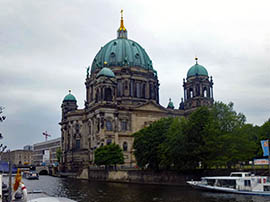
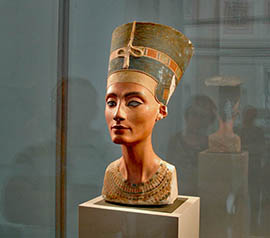
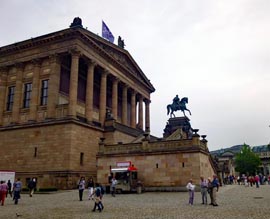
-
Berlin's Museum Island is the area between the Spree River and the Spree Canal
north of the Unter den Linden.
- This diagram tells the distribution of the museums in this area.
- The Museum Island is still under reconstruction as can be seen from
this photo taken from a fourth-floor room of Berlin's Radisson Blu Hotel.
- Berlin Dome is at the intersection of
the Unter den Linden and the Spree River. This is an old church with its
history. Inside the Church,
- Tourists taking rest.
- Main altar.
- Ceiling under the dome.
- Church organ.
- The Alte Museum is the old museum.
It used to contain Egyptian items. This museum looks like
this from the Unter den Linden.
This museum used to display Egyptian items, and thus was called the
Egyptian Museum in the past. These days, those Egyptian items were transferred to
the nearby Neuse Museum.
The Egyptian collection includes
- Bust of Queen Nofretete.
- Egyptian ship driven by slaves.
- Egyptian goodies.
- Egyptian god giving you strength.
- The Alte National Gallerie has its long history. This museum gives exhibitions of modern and classical paintings people want to see. It is always crowded.
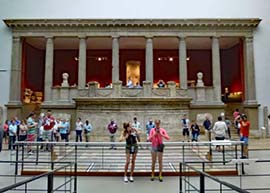
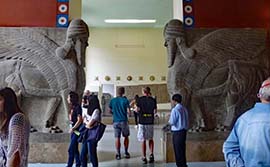
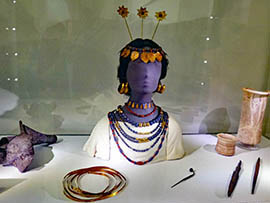
- The Pergamon Museum
in the Museum Island is very famous for its collection of the historical items
from the Mesopotamian, Persian and the Eastern Mediterranean areas.
- Let us look at the map of the area
from which the items are collected.
- The main entrance of this museum is still
under reconstruction. The museum is open to the public through
a temporary route.
While making a detour, you can see
the sign on the Museum wall.
- The Museum collections include many Roman items since Romans were in control of Turkey and Egypt. Here is one of the Roman governments.
- Another Roman structure, and
Roman floor.
- Persian wall, and Persian warriors.
- Persian horses, and
Persian palace.
- Babylonian monument, and Babylonian decrees.
- Dinner plates, and
decorations for women.
- Click here for more photos.
- Let us look at the map of the area
from which the items are collected.
- Bruecke. Paintings of the
Bruecke German group of artists, including Ludwig Kirschnev,
Schmidt Rotluff, Emil Nolde hanging on the wall of a Dresden restaurant
called "die Bruecke" (June 2004). What does die Bruecke (the bridge) mean?
Click here.
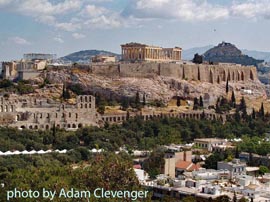
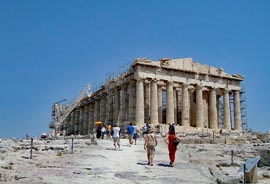
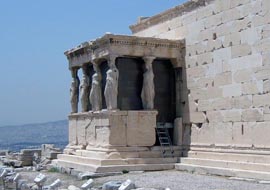
- Acropolis Hill of
Athens is of course one of the greatest museums of the world.
Click here
for its history.
- Parthenon Temple. It has a long and glorious but painful history. Click here.
- I was there in 1999. I was there again in 2008 and had a photo with two sisters from Brazil.
- The Hill seen from the Agora market (north of the hill).
- The Temple seen from the Acropolis Museum (south of the hill).
-
The Museum and Theatre of Dionysus Eleuthereus seen from the Hill.
This theater, located at the southern foot of the Hiill, could seat as
many as 17,000, and is the birth place of
Greek tragidy.
- In 1999, I had a photo with
this piece of a column. In was there again in 2018. I was so happy to meet
this beautiful stone again. I hope to see the same stone again in the future.
- Women pillars on the porch of maidens attached to the Erechtheion Temple, located near the Parthenon. Here is another photo. These statues are reproductions of government building in Vienna. It is interesting to see that Egyptians used human pillars in there arcicheccture before Greeks. Click here for an item at the Vatican Museum in Rome. This suuports my belief that creativity is always a product of continuity.
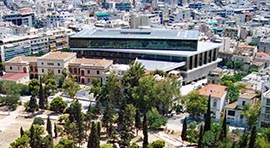
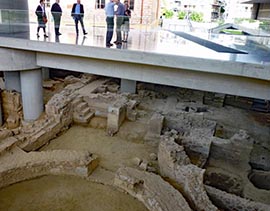
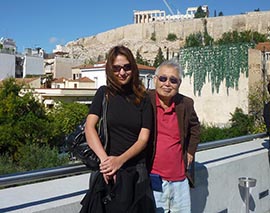
- Acropolis
Museum. It is a challenging job to reconstruct the Parthenon Temple by collecting
all the pieces. Many of them are in the British Museum in London, but most
of them are still in Athens. Instead of rebuilding the Temple, the Greek government
decided to build a museum consisting of all the remains from the Temple. It is
called the Acropolis Museum. This idea was created by
Melina Mercouri, who once served her country as
the minister of culture.
- The Museum seen from the top of the Acropolis Hill.
- In front of the entrance to the museum building, there is a transparent glass floor and an opening.
- Underneath the floor, there are
archeological items collected from the Acropolis grounds. Here is
one more photo,
and another photo.
- Photos are not allowed in the exhibition halls, but I took some photos at the corridors outside the halls. Here is one of them.
- These are the art works
shown on the corridor wall.
- Parthenon Temple seen from the Museum cafeteria.
- As always God's art work with life
is more beautiful than any of those stone works. I told her she is more
beautiful than Melina Mercouri. She did not disagree. She said Melina has
a different hair color. This photo was taken at the Museum's cafeteria
terrace. The Parthenon Temple is seen in the background.

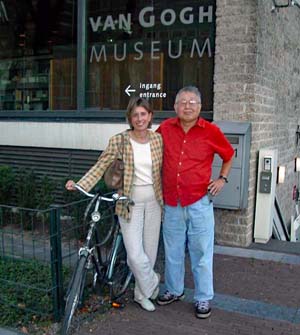
-
The Rembrandt House is in Amsterdam. I was
there in 2008.
- Recently the city of Amsterdam erected a statue of Rembrandt at the Rembrant Plaza.
- Many of his paintings are at the Rijksmuseum (Dutch National Museum). I was there in 2003, and again in 2008. However, I was not allowed to take photos there.
- Click here for the Wikipedia list of Rembrandt's paintings.
- Van Gogh Museum in Amsterdam
(August 2003). The Museum was closed when I went there, but a Dutch
lady was kind enough to invite me to produce our own artwork. We look
nice in this photo. Since then,
a new building
was constructed for the
Museum, but I have not beenm there. I was at the Van Gogh House in
Arles (France) near Marseille.
- I am standing at the entrance of the Van Gogh House in Arles.
- This bed in his bed room is a reproduction. The original bed is lost during World War II.
- This is Van Gogh's self portraist.
- The city of Arles was construced by ancient Romans. They still use the stadium originally built by Romans. The outside wall of this stadium looks like this.
- Here is the Wikipedia list of Van Gogh's paintings.
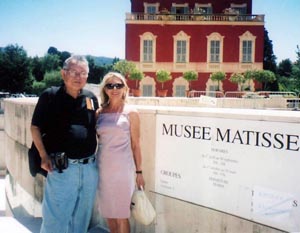
- Matisse Museum.
The Museum dedicated to Henri Matisse is in Nice, but this museum
does not allow photographing inside the building. I decided to make
my own artwork outside the building. The French lady standing with
me came from Strasbourg near Germany. She said Mount Donan is close
to her city and knew how
Victor Hugo was born.
- Shagall Museum. Aonther creative
art work outside the museum dedicated to Marc Shagall. This lady
came from the Netherlands, and the photo was taken by her husband.
Photo without flash. This
museum allows photographing without flash, and I found a painting
with enough sun-light for this photo.
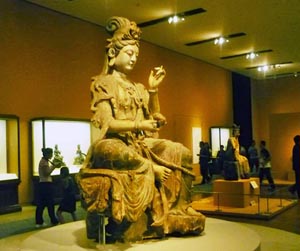
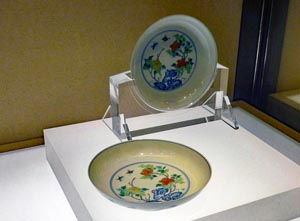
-
National Museum of China. China has a long history, and Chinese take
their history very seriously. Their National Museum is located in
the center of Beijing just east of the Tien-An-Min Square.
- The Museum seen from
the Tien-An-Min Square.
- Cooking device from the ancient period. Another device.
- Statue of Buddha during the Tang period (600 - 900 AD)
- Statue of Buddha during the Song period (900 - 1200 AD)
- Porcelain jar during the Qing period (1650-1900).
- China plate during the Qing period. Louis XIV of France was quite fond of Chinese porcelain during his reign, and France used to import large quantities of Chinese porcelain products. This is the reason why the dinnerware sets are called China sets in the Western world.
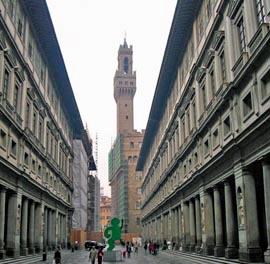
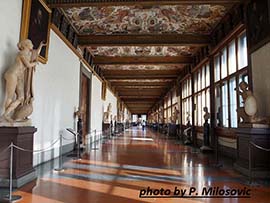
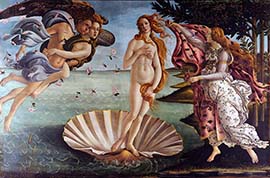
- The Museum seen from
the Tien-An-Min Square.
- Uffizi Gallery
consists of the collection of the Renaissance art works. They are housed
in the former Medici banking headquarters in Florence. I have been
inside the museum twice, but was not allowed photograph any of the items.
However, many of those items are in the public domain and available from
webpages.
- Indeed, the twin Uffizi buildings used to serve as the World Trade Center of their time. Those two "Uffizi" building used to be Medici's "Office" buildings. Right! "Uffizi" sounds like "office."
- This is an image of the main hall way of the Gallery.
- These twin buildings were and still are separated by a street
called the Uffizi Courtyard.
Here are the photos of the
Courtyard taken from the fourth and second floors of western
building. There are many statues of those creative Italians.
I had a photo of myself in front of
Leonard da Vinci.
- You have seen this painting of Venus by Sandro Botticelli. This painting is in this Museum.
- Many of those paintings are now in the public domain. However, you can see most of the famous items by going to the Wikipedia page.
- Florence. The entire city is a great museum.
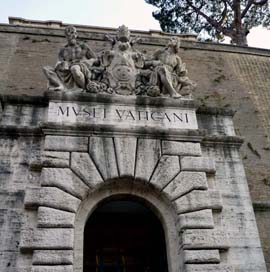
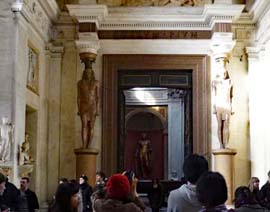
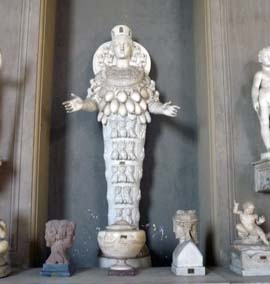
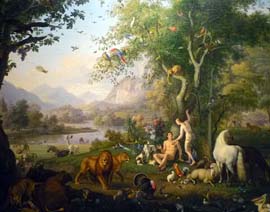
- Vatican
Museum contains many valuable historical items, covering Egyptian,
Greek and Roman civilizations. Its core is the Sistine Chapel consisting
of Michelangelo's masterpieces. You have to make at least one pilgrimage
to this holy place if you wish to be regarded as a civilized person.
- Entrance to the Vatican Museum.
Vatican is a walled city, and its entrance is one of the wall entrances.
This museum is not open everyday. You have to check the Museum schedule before
going there.
- Egyptian Human Pillars. From this, it becomes quite clear that Greek human pillars can be traced back to the Egyptian civilization. Many people are taking photos. I used to think Greeks invented this form of art. Click here.
- There are many Egyptian items
arranged to teach us lessons.
- Artemis was the Greek goddess of fertility. Apostle Paul got into trouble for saying a man-made idol is not a real god in the Greek city of Ephesus now in Turkey.
- Bust of Emperor Hadrian. Hadrian ruled the Roman Empire from 117 to 138 AD. He was a talented man. He was a gifted architect and built Rome's pantheon. He was also a brilliant military man. He consolidated the boundary of the Empire.
- Garden of Eden. This painting
catches your eyes. God created a woman by pulling out one rib from a
man's body. My grandmother told me I have one less rib on my left chest.
When I counted the ribs from my X-ray photo, I have the same number on
each side. Thus, I had to create my own theory of the Garden of Eden.
Click here if you are
interested.
- This Museum is high-rise building and employes modern technology. It has escalators as well as spiral stairways.
- It has an open space for fresh air. The dome of St. Peter's Basilica is seen. From this you can figure out how high this place is.
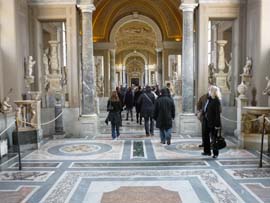
- Entrance to the Vatican Museum.
Vatican is a walled city, and its entrance is one of the wall entrances.
This museum is not open everyday. You have to check the Museum schedule before
going there.
- Entrance to the Sistine Chapel. There
some distance between the entrance to this Chapel and the entrance to the Museum.
You have to walk, and you will get tired when you reach the Chapel.
- Sistine Chapel. You are not allowed to take photos in this chapel, but many people do. I also took many photos when I was there in 2009. However, it would not be right to post them to this webpage. Instead, I am asking you to go to this Wikipedia page for a comprehensive coverage of this important place.
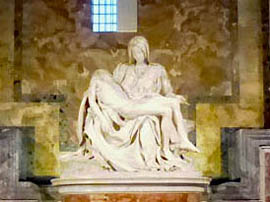
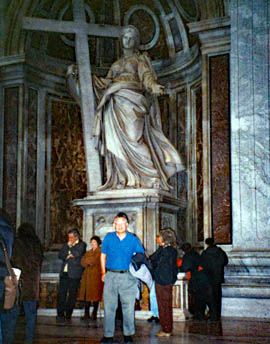
- Saint Peter's Basilica is a also great Museum, with
its unique interior, and
so many art items. Let us see some of the photos.
Some of the following photos are taken by me and others are from the public domain.- Michelangelo's Pieta is in this Basilica. I took a photo, but its quality is not satisfactory. You are invited to Wikipedia's Pieta for a professional-quality photo.
- Shrine of Saint Helena by Bolgi.
This art work appears often on TV and is familiar to us all.
Who was St. Helena ?
- Saint Peter's Chair
behind the main altar. - Statue of Saint Peter, and
another statue.
- Statue of St. Veronica by Mochi. Who was Veronica?
- Statue of St. Andrew by Dusquesnoy.
- Statue of St. Longinus by Bernini.
- Tomb of Alexander VII, with a
marble sheet.
Click here for a professional-quality photo from the Wikipedia.
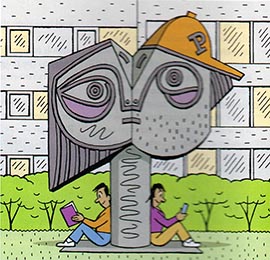
Picasso's image of a woman stretched, from the PU Alumni Weekly. - Princeton University Art Museum
has a very respectable collection of art works. I once asked the museum
director how he got those expensive items. He said Princeton has many
rich alumni.
- Picasso Sculpture used to be in front of the Art Museum. This art piece called the "Head of a Woman" was constructed by a Norwegian artist Carl Nesjar in 1971 under the supervision of Pablo Picasso. This sculpture has been moved to a corner of the campus near the railroad station. The campus made a mistake.
- Extension of Picasso's Imagination.
The Princeton Alumni Weekly in its issue of April 6 (2011) carried
this drawing of the Picasso woman. It related the woman's face with
book pages.
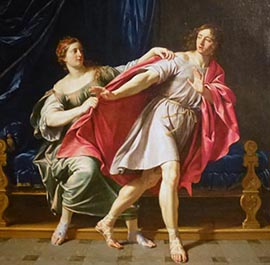
- Joseph and General's Wife. I heard the
story of Joseph in Egypt from my grandmother when I was 9 years old. I still
remember her expression when she was talking about how Joseph was arrested.
She had to skip the details because she knew I was too young to understand
what a woman can do to a man.
- Greek jar in the Greek section.
- A statue in the Indian section.
- Roman floor in the Roman section.
- Items in the Egyptian section
- Goerge Washington and
Marilyn Monroe in the American room.
- The University Campus is a big art museum.
- The lifestyle of affluent Americans can be seen from Princeton's alumni reunion events.
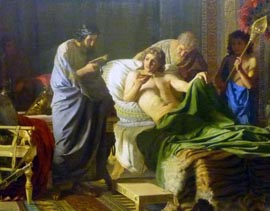
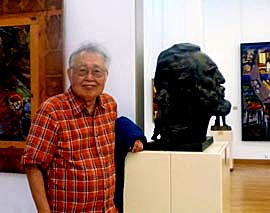
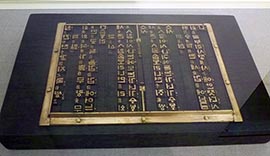
- Alexander the Great with his Doctors
in the National Museum of Arts in Minsk (Belarus). This museum has many items
that cannot be seen at other places.
- German Officers being escorted by communist guerillas during the Great Patriotic War (World War II). The woman fighter in this painting is carrying a Shpagine machine gun. I know how to operate the Shpagine with a drum-like magazine. How many of you have seen this machine?
- Fidel Castro's Bust. Castro was a great hero for the Soviet Union. The ideology is not a serious issue these days, and Castro is admired by many people in the United States, as a long-living ruler of Cuba standing up against the powerful neighbor. He served eleven U.S. presidents since 1959, and most of them pledged to get rid of him. I was the first-year graduate student when Castro took over the Cuban government in 1959, and I am still publishing papers. Please admire me!
- Korean Copper Printing Plate, telling Koreans love to write and print. They developed their own printing technology. I was very happy to see this item, because it was telling about myself.
- Chinese Musicians. I met these musicians in this art museum. They came here for a special Chinese program.
- Ceramic Jar dedicated to Vladimir Lenin, Joseph Stalin, and the Soviet Union.
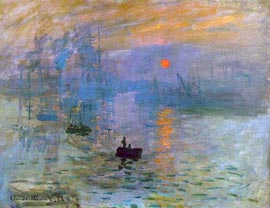
-
In 2014, I was fortunate enough to visit the Monet Garden at Giverny
about one-hour bus ride from Paris. The Garden was designed to reflect
Claude Monet's paintings. I took some photos there, and let us look at
some of them.
- In order to understand Monet, let us look at his
Sun Rise. During the sunrise, the color of the world changes continuously.
Monet wanted to accommodate all those different colors in one painting.
This certainly is an issue of harmony. As a consequence, this picture
looks differently to different people. This painting is now in the
Musée Marmottan Monet in Paris.
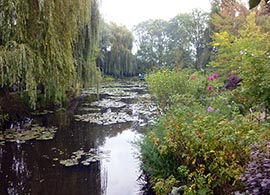
- Flowers at the Monet Garden.
- Bamboo and Water.
- Flowers and Brook.
- Garden of Eden? Unlike Adam, I have the same number of ribs on both sides. Thus, God must have pulled out two ribs from me to make two women. Consequently, I look happy when I have a photo with two philippine sisters. Indeed, the Monet Garden became my Garden of Eden.
- To me, the entire world is my Garden of Eden. How is it possible? I keep in mind what God told me.
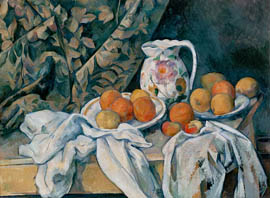
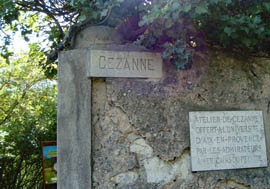
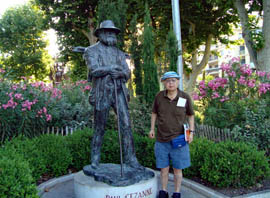
- In order to understand Monet, let us look at his
Sun Rise. During the sunrise, the color of the world changes continuously.
Monet wanted to accommodate all those different colors in one painting.
This certainly is an issue of harmony. As a consequence, this picture
looks differently to different people. This painting is now in the
Musée Marmottan Monet in Paris.
- Paul Sezanne
was born in Aix-en-Provence near Maseille (France), and maintained his house
(not necessarily his birth house) there. He painted many picures there. I
was inside the house bu not allowed to take photos. This house is within a
wooded area, and it is not difficult to see that his paintings were influenced
by the natural beauty surrounding the house. Let us see some photos.
- This is the entrance to his house.
- This roadway leads to the house.
- I am sitting at the outside table, which seems similar to (if not the same as) the table Cezanne used to enjoy.
- His house is hidden by trees. There are inside the house many painting tools Cezanne used to create his great paintings. I was not allowed to photograph them.
- How about his paintings? Not there. However, there are always Cezanne exhibitions going on around the world. I went to one exhibition held at the Musée du Luxembourg in Paris. I went to another Cezanne exibition at the National Gallery of Art in Washington.
-
Click here for the Wikipedia list of his paintings.
- Aix-en-Provence is a beautiful city. This city should be proud of Paul Cezanne. There is his statue at the city center. Its environment reflects the beauty of his paintings.
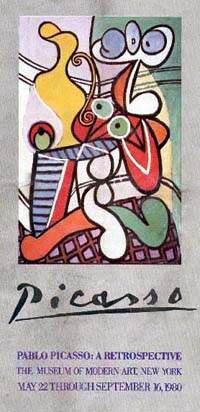
-
In 1980, there was a Picasso exhibition
in New York City. I went there and received a basic education on
this great artist.
- Picasso Plaza. In 1992, while I was in Madrid (Spain), I visited the Picasso Square.
- I like Picasso, because he forces me to think. I own many Picasso itmes including two necties carrying Picasso's paintings.
- Picasso Tie. In this photo with Anton Zeilinger, I am wearing a Picasso nectie. This photo was taken during the banquet honoring John A. Wheeler (Princeton, March 2002).
- Chateau Grimaldi seen across from the Antibes bay (June 2006). Closer to the Chateau and the Picasso Museum. Here is the Museum website.
- Picasso (2006-7).
There was another Picasso exhibition at New York's
Solomon Guggenheim Museum.
- Variation of Botticelli's Venus. This painting (not by Picasso) allows us to compare the Picasso style with the Renaissance style. In this way, we can understand what Picasso is all about.
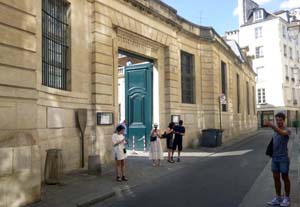
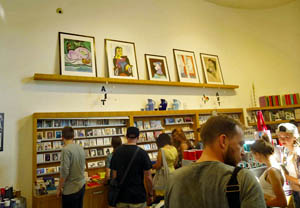
- Picasso Museum of Paris
is about 2 km north-east of the Le Halles metro station, and 1 km south of the
Republic Square. Let us look at some photos.
- The road sign leading to the Museum.
- Entrance the Museum quadrangle.
- Museum's main hall seems to be a very old building.
- Entrance to the Museum exhibition hall. I was there two hours before the closing hour, and was able to avoid the waiting line. The waiting line is very long during the earlier hours.
- Museum Store sells many Picasso items. They are of course unreasonably expensive.
Like all artists, Picasso created many images of women, and I assume that he was interested in making them more beautiful than God's creation. Click here for a variation of Botticelli's Venus, and its variation by someone who really wanted to understand Picasso.
- I am standing next to one of Picasso's ladies.
- We can compare her with Paul Cezanne's
women.
- Is she necessarily more beautiful than God's creation? Was Picasso interested in moving in the opposite direction? Without asking this question, let us continue.
- Two women in this frame.
- How many women are in this picture?
- One of his women sculptures.
- Here is another. Did Picasso hate
women? If so, why?
- Between two Picasso ladies, I am happy to have a photo of myself. Here are two more ladies.
- In my Garden of Eden, I am standing with two ladies God created for me.
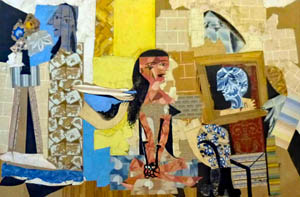
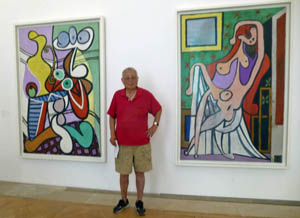
-
Click here, if you are not satisfied the collection of
Picasso paintings given above.
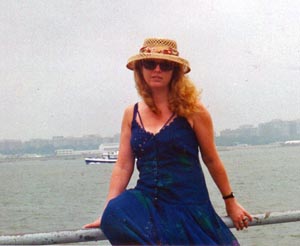
- Elena Georgieva is
a physicist who published papers with me. She is also a very
talented artisit. Here are some of her paintings.
- Richard Feynman was
a talented artist. He was of course a great physicist.
- Pictures in my office . One of
them is Millet's Angelus, and the other is Paul Gauguin's painting .
-
Museums around the World.
-
http://www.bluffton.edu/~sullivanm/index/index2.html.
Art historical images of sculpture and architecture from prehistoric to
post-modern.
- Digital Literature, art of making webpages.
- Mother and Son
generate an abstract concept of "Good."
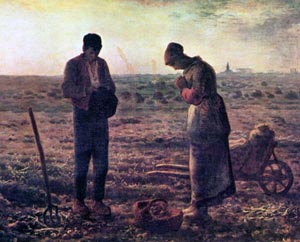
|
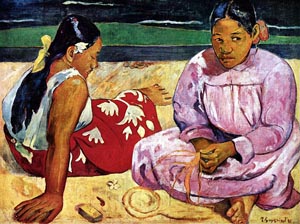
|
I have many more photos to add to this page. I hope to do this when I have time. Please come again.
- copyright@2019 by Y. S. Kim, unless otherwise specified.

How did I talk to Einstein? - Click here for his home page.
- His photo-biography.
- His Princeton page.
- His Einstein page.
- His Style page.

I received my PhD degree from Princeton in 1961, seven years after high school graduation in 1954. This means that I did much of the ground work for the degree during my high school years.